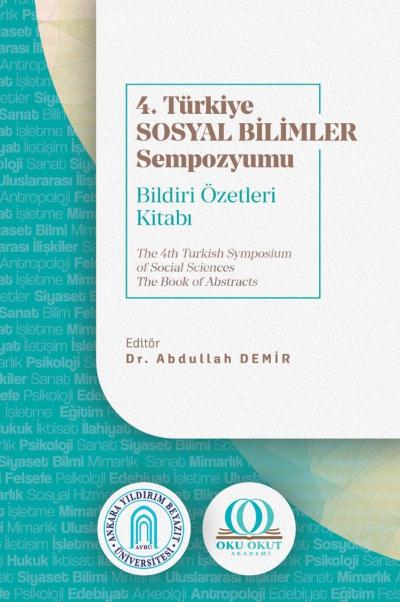Oku Okut Yayınları, kitabın yayım ve dağıtım hakkını saklı tutar. Ticari kullanım için yayınevine başvurulması gerekir.
Molla Jāmī’s Commentary on the Example of Surah Fatiha
Fatiha Suresi Örnekliğinde Molla Câmî’nin Tefsirciliği
Yazarlar
-
Yüksek Lisans Öğrencisi Süleyman Arslanhttps://orcid.org/0009-0006-9310-6585
Molla Jāmī (d. 898/1492), who is known as an Iranian Mullahandpoet, is mostly known in our country for his literary work Baharistan and his Works Nefahat al-uns. One of the Works written by Molla Jāmī is a work on interpretation called Tefsiri Molla Jami. According to the author's own statement, he started writing this work in the last years of his life. However, for some unknown reason, his tafsīr could not be completed. Only until the fortieth verse of Surah Al-Baqara could be interpreted. However, even this much is enough to provide sufficient information to understand al-Jāmī'sTafsīrs. While tafsīred the verses, the commentator first analyzed the root of the word in terms of the science of sarf in each verse, and then focused on the meanings of the words. He tried to analyze each word in terms of the science of grammar and rhetoric. The author, who also includes the differences of qiraat in the verses, has also made explanations about fiqh issues where necessary. He tried to touch up on my stical points in the verses as much as possible. In this respect, her tafsīr has the characteristic of dirayah tafsīr. However, the main center of his tafsīr linguistic analyses and mystical interpretations includes. It can be said that Jāmī, who is understood to be in line with ez-Zamakhsharī (d. 538/1144) regarding the miracul ousnessande loquence of the Quran, is close to the view and thoughts of Muhyiddin Ibn al-Arabī (d. 638/1240), one of the pioneers of theoretical-Sufi interpretation, in Sufi interpretations. Although different academic studies have been carried out on various works of Mulla Jāmī in our country, the aspect of tafsīr has almost never been emphasized. The fact that the author is known to have a work on tafsīris important in terms of being the subject of academic studies. This study aims to present a new perspective on linguistic tafsīr by analyzing the tafsīr of al-Jāmī, who is also a scholar of grammar. In our study, Surah Fatiha will be taken into consideration and Molla Jāmī's tafsīr will be analyzed through the example of Surah Fatiha. As a method during the examination, the way the tafsir handled the subject in the tafsīrs of the verse, the sources he used and the views he was influenced by were tried to be determined, text analyses were included and it was aimed to better under stand the subject through examples.
* This study is based on the master's thesis titled ‘Molla Jāmī's Method of Tafsīr’, which we are continuing under the supervision of Prof. Dr. Mehmet Halil Çiçek.
İran’lı mutasavvıf ve şair olarak tanınan Molla Câmî (öl. 898/1492), ülkemizde daha çok edebiyat alanındaki Baharistan isimli eseri ve tasavvuf ile alakalı Nefahatü’l-üns isimli eserleriyle tanınmaktadır. Molla Câmî’nin kaleme almış olduğu eserlerinden birisi de tefsire dair olan ve Tefsiru Molla Câmî diye isimlendirilmiş olan eseridir. Müellifin kendi beyanına göre bu eseri ömrünün son yıllarında yazmaya başlamıştır. Ancak bilinmeyen bir nedenden dolayı tefsiri tamamlanamamıştır. Sadece Bakara suresi kırkıncı ayete kadar tefsir edilebilmiştir. Ancak bu kadarı bile Câmî’nin tefsirciliğini anlama açısından yeterli bilgiyi verecek kapasitededir. Müfessir, ayetleri tefsir ederken her ayette evvela kelimenin sarf ilmi açısından kökünü incelemiş, daha sonra kelimelerin anlamları üzerinde durmuştur. Her bir kelimeyi nahiv ve belagat ilmi açısından incelemeye çalışmıştır. Ayetlerdeki kıraat farlılıklarına da yer veren yazar, ihtiyaç duyduğu yerlerde fıkhi konular hakkında da açıklamalarda bulunmuştur. Ayetlerde mümkün oldukça tasavvufi noktalara değinmeye çalışmıştır. Bu yönüyle tefsiri, dirayet tefsiri özelliği taşımaktadır. Bununla beraber tefsirinin ana merkezinde dilbilimsel tahliller ve tasavvufi yorumlar yer almaktadır. Kur’an’ın i’caz ve belagati konusunda Zemahşerî (öl. 538/1144) çizgisinde olduğu anlaşılan Câmî’nin, tasavvufi yorumlarda nazari-sufi tefsirin öncülerinden Muhyiddin İbnü’l-Arabî’nin (öl. 638/1240) görüşlerine ve düşüncelerine yakın olduğu söylenebilir. Ülkemizde Molla Câmî’nin muhtelif eserleri üzerinde akademik anlamda farklı çalışmalar yapılmış olsa da tefsircilik yönü üzerinde neredeyse hiç durulmamıştır. Müellifin tefsire dair bir eserinin de olduğunun bilinmesi, akademik çalışmalara konu olması bakımından önemlidir. Bu çalışma ile, kendisi de nahiv âlimi olan Câmî’nin tefsiri incelenerek, dilbilimsel tefsire yeni bir bakış açısı sunmak amaçlanmıştır. Çalışmamızda Fatiha suresi ele alınarak; Fatiha suresi örnekliği üzerinden Molla Câmî’nin tefsirciliği incelenecektir. İnceleme esnasında yöntem olarak, müfessirin ayetin tefsirinde konuyu ele alma biçimi, başvurduğu kaynaklar ve etkilendiği görüşler tespit edilmeye çalışılarak, metin analizlerine yer verilmiş ve örnekler üzerinden konunun daha iyi anlaşılması amaçlanmıştır.
* Bu çalışma Prof. Dr. Mehmet Halil Çiçek danışmanlığında devam etmekte olduğumuz “Molla Câmî’nin Tefsir Yöntemi” başlıklı yüksek lisans tezinden yararlanılarak hazırlanmıştır.
Telif Hakkı
Telif Hakkı (c) 2024 Oku Okut Yayınları
Lisans

Bu çalışma Creative Commons Attribution-NonCommercial 4.0 International License ile lisanslanmıştır.
İndir
Yayın Bilgisi
-
Yayın TürüBölüm
-
Cilt
-
Sayfalar143-146
-
Yayım Tarihi24 Ağustos 2024
-
Dizi
-
Dizi No.6
-
Kategori
Arslan, Süleyman. “Fatiha Suresi Örnekliğinde Molla Câmî’nin Tefsirciliği”. 4. Türkiye Sosyal Bilimler Sempozyumu: Bildiri Özetleri Kitabı. ed. Abdullah Demir - critical ed . 6/143-146. Sosyal Bilimler Bildirileri. Ankara: Oku Okut Yayınları, 2024. https://doi.org/10.55709/okuokutyayinlari.322












